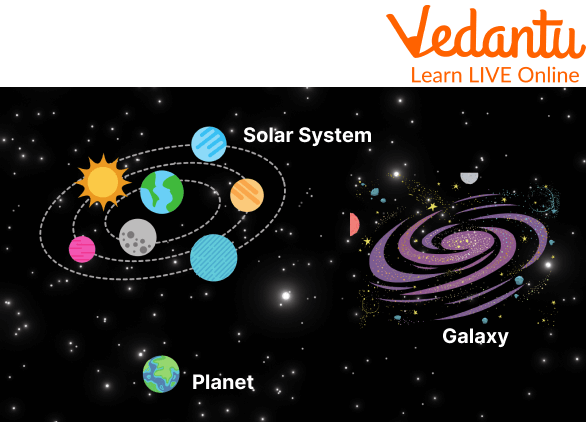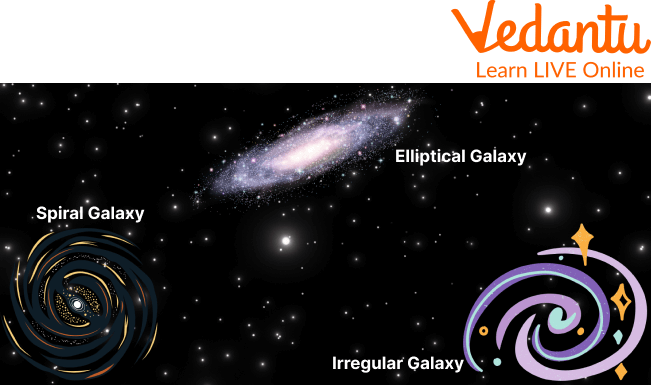




What is Galaxy?
A galaxy is a group of planets and stars that are bound collectively by gravity. The celestial bodies in a galaxy revolve around a primary object. The Milky Way is the name of our galaxy. The Sun and the planets that orbit it make up our solar system, which is a small portion of that galaxy.

The Galaxy
According to their optical shape, galaxies can be classified as elliptical, spiral, or uneven. It's believed that the centres of several of them contain supermassive black holes. A thin gas with an average density of fewer than one atom per cubic metre fills the gap between galaxies.
The Shape of The Galaxy
An irregular galaxy is any galaxy without a clear spiral or elliptical shape. While some irregular galaxies are the result of different galaxy types colliding with one another, others may have just formed that way. With a diameter of 120,000 light-years and a potential 400 billion stars and planets, our Milky Way Galaxy is a barred spiral galaxy.
About 27,000 light-years from the galaxy's galactic centre, the Milky Way Galaxy's disc contains the location of our Solar System. The majority of galaxies are thought to contain supermassive black holes. A "Local Group" of galaxies, wherein the galaxies move about one another, includes our Milky Way Galaxy.
Types of Galaxies in Space
There are three primary types of galaxies in space: elliptical, spiral, and irregular.
1. Elliptical
Elliptical galaxies are usually shaped like ellipses. Ellipse are the geometrical shapes that looks like a flattened circle. There are saome galaxies in the space that have an ellipsoidal profile, which makes them appear elliptical from any angle. They typically have a little amount of interstellar matter, and their appearance displays little structure. As a result, fewer open clusters and fewer young stars are being formed in these galaxies. Instead, they are typically dominated by more evolved, older stars that orbit the central gravitational field randomly. An example is Messier 87 (Virgo A or M87)
2. Spirals
Spirals galaxies are the most notable (and therefore the most commonly observed) type of galaxy. In a spiral galaxy, older stars orbit around the centre more quickly than newer stars, and spiral outward from it. Because of this rotation, gas and dust can accumulate and form new generations of stars. A common example of a spiral galaxy is the Milkyway.
3. Irregular
Galaxies that are unable to be easily categorised as having an elliptical or spiral form are known as irregular galaxies. Despite having some structure, an Irr-I galaxy does not neatly fit into the Hubble classification system. Irr-II galaxies may have been disturbed and lack any structure that resembles a Hubble classification. The Magellanic Clouds are nearby instances of (dwarf) irregular galaxies.

Types of Galaxies
Milky Way
The Milky Way is the galaxy that contains our sun, as well as all of its planets, stars, and other celestial bodies. It is a spiral-shaped galaxy about 100 thousand light-years in diameter and about 25 thousand light-years thick. Most stars are found in small star clusters scattered throughout this region rather than near the galactic center. The Milky Way contains more than 200 billion stars, with only 4 per cent having been identified so far.
Other Different Galaxies
1. Interacting:
Galactic interactions are relatively common and have a significant impact on galactic evolution. Tidal interactions during close encounters between galaxies induce warping distortions and may result in some gas and dust exchange.
2. Starburst:
Within galaxies, a supply of cold gas that condenses into enormous molecular clouds is used to make stars. Starbursts, which occur when galaxies generate stars very quickly, have been seen in some galaxies.
3. Active Galaxy:
If a certain observable galaxy has an active galactic nucleus, it is deemed to be "active" (AGN). Instead of the galaxy's stars, dust, and interstellar medium, the active nucleus emits a considerable amount of the galaxy's overall energy production.
Characteristics of Galaxies
Let us have a look at the characteristics of galaxies:
Galaxies have their magnetic fields. They are powerful enough to have a significant impact because they: Motivate the inflow of mass into the galactic centres.
They alter the way spiral arms form. Gas rotation in the outer parts of galaxies may be impacted by this. It offers the angular momentum conveyance necessary for the implosion of gas clouds, and subsequently the creation of new stars.
Groups of stars and other matter are present in every galaxy and are bound together by gravity.
Interesting Facts About Galaxy
The word "galaxy," which refers to our galaxy, the Milky Way, is derived from the Greek word galaxias, which means "milky." The observable universe may contain more than 170 billion galaxies. While some are enormous and contain an estimated 100 trillion stars, others are quite small and have just a few million stars, known as dwarf galaxies.
Astronomers have classified many types of galaxies according to their shapes, including elliptical, spiral, lenticular, and irregular galaxies. With at least two spiral arms of younger stars stretching out from a central bulge of older stars, spiral galaxies are revolving flattened disk-shaped objects. Star formation is active in the spiral arms of spiral galaxies' dense molecular clouds of hydrogen gas and dust.
Summary
Galaxies are vast systems of gravity-bound gas, dust, dark matter, and anything from a million to a trillion stars. Supermassive black holes are expected to be present at the centres of almost all big galaxies. However, there are countless other galaxies besides our own. There are so numerous that we are still unable to count them all. For 12 days, the Hubble Space Telescope observed a small region of space, and it discovered 10,000 galaxies of all sizes, shapes, and hues. According to some physicists, the universe may contain as many galaxies. This answers all questions related to the galaxy like what is galaxy and its types.
FAQs on Facts About Galaxy
1. How many galaxies exist?
The number of galaxies in the universe was found to be around 170 billion. However, our current estimate is even more impressive: two trillion galaxies.
2. How far is the galaxy from the earth?
Various models have estimated the distance of the galaxy from earth to be anywhere from 12.2 billion light-years to 14.4 billion light-years, but these measurements are outdated, taking into account the errors in previous estimates' data sets. New measurements taken show that the galaxy lies about 13.1 billion light-years from Earth.
3. Are all the galaxies in the universe discovered?
No, all galaxies in the universe are not discovered. More Galaxies will be discovered as better technology becomes available to astronomers.





















